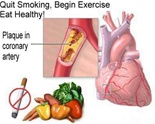
Blood Pressure Chart
High Blood Pressure (Hypertension) and Diabetes
Diabetes is very closely associated with high blood pressure – a condition also known as hypertension. It is estimated that about 75% of adults that have diabetes also have high blood pressure and that a person with diabetes is about twice as likely to get high blood pressure than someone without diabetes.
High blood pressure occurs when arteries get filled with residue, such as cholesterol. Cholesterol decrease the passageway through which blood can flow. As the passage gets smaller, the heart has to pump harder to push blood through the arteries, which increases blood pressure.
It may help to think of high blood pressure by thinking of your arteries as a garden hose. If the garden hose becomes filled with dirt, it is more difficult for water to flow through the hose. The pressure within the hose, therefore, increased, even if the flow of water is not as strong.
As such, high blood pressure often leads to poor circulation and swelling. Additionally, when a person has high blood pressure, he or she is four times as likely to develop heart disease and has an increased chance of getting a stroke.
The most common way to get a blood pressure reading is through the use of a cuff Ð or a canvas band that fits around an arm or a leg. The device measures systolic (si-stol-ik) and diastolic (dahy-uh-stol-ik) pressure by pumping air into the cuff until the cuff is snug around the arm or leg.
Systolic pressure is the pressure inside of the artery that builds every time the heart contracts to push blood through the arteries. The diastolic pressure is measured when the heart is resting (after each beat) and filling with blood. When your blood pressure is read, the systolic number is always on the top (the larger number) and the diastolic number is always on the bottom (the smaller number).

According to the National Heart, Lung, and Blood Institute (NHLBI), high blood pressure is:
¥ A diastolic measurement of at least 90 mm Hg
Hypertension is characterized by headaches, dizziness and blurred vision. Because these symptoms are also associated with other conditions, they can be hard to identify as symptoms of high blood pressure. Therefore, it is important to get a regular blood pressure check from your doctor.
Hypertension is a common condition amongst Diabetics. However, there are some lifestyle changes that you can make in order to reduce your chances of getting high blood pressure:
¥ find methods of reducing stress
¥ stretch
¥ exercise regularly
¥ lose weight
¥ avoid consuming large amounts of alcohol
¥ donÕt smoke
¥ get regular blood pressure check-ups
If you think that you have hypertension, consult your physician immediately. Addressing hypertension early is the best way to avoid the health risks that are often associated with the condition.
Reduce High Blood Pressure With Diet & Exercise





